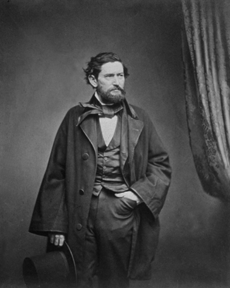
Jack Hays
In his book, Texas Rangers, Walter Prescott Webb
describes Hays:.
John C. Hays, known in Texas as Jack Hays, was born at Little
Cedar Lick, Wilson County, Tennessee, on January 28, 1817. He was
from the same section of the country as the McCullochs, Sam Houston,
and Andrew Jackson, and was the same adaptable sort of person. It
is said that Jackson purchased the Hermitage from Jack Hays's grandfather,
John Hays, who served with Jackson in some of his Indian wars, and
who built Fort Haysboro. Jack's father, Harmon Hays, also fought
with Jackson and named his son for General John Coffee, one of Jackson's
trusted officers.
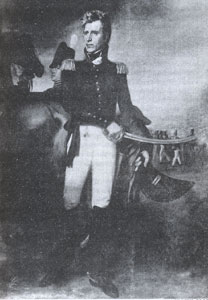
Andrew Jackson. From a painting in New York City Hall.
In his book, Men Who Wear The Star, Charles M.
Robinson, III includes Ranger Lockhart's description of his captain:
In the dry and rocky portions of West Texas a squad of fifteen
or twenty Indians could go through the country without leaving much
sign, consequently a trailer was considered a very effective man.
This faculty Captain Hays had to a very marked degree, it almost
amounted to instinct with him; he could ride along at a good pace
and see the signs where other men could see nothing, hence his great
tact in overhauling and finishing Indians. It is said that often
he could dismount and observe the small pebbles, and by noticing
the slightest displacement made by the horses, could, in a moment,
tell in what direction they had gone.
Webb also quoted Hays' Lipan Apache scout, Flacco:
"Me and Red Wing not afraid to go to hell together. Captain
Jack heap brave; not afraid to go to hell by himself."
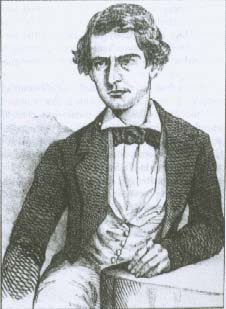
Captain Jack Hays
About 1844, Kit Ackland, Mike Chevalier, Creed Taylor,
Noah Cherry, an Irishman named Paddy, and others, under the leadership
of the brave and bold John C. (Jack) Hays, made an expedition up the
Nueces River in search of Indians. But no Indians were found, so the
rangers started home. After traveling for a considerable distance, someone
about noon discovered a bee tree, and the point of entrance of the bees
was a considerable distance, someone about noon discovered a bee tree,
and the point of entrance of the bees was a considerable distance from
the ground. Noah Cherry took a small axe and ascended the tree to get
some honey; and his position gave him a splendid perspective of the
surrounding country. At a moment when least expected he sang out, “Jerusalem!
Captain, yonder comes a thousand Indians.” Since they were coming
at a rapid gait, Captain Hays who was sitting on the ground, jumped
to his feet and exclaimed, “Come down from there quick! Men, put
on your bridles, pick up your ropes. Be ready for them! Be ready for
them! The rangers were armed with two colt five or six shooters, a rifle
and a holster single-shot pistol.
Captain Jack Hays has been credited with having never
lost a single Indian battle, although he was almost invariably greatly
outnumbered. On this occasion, he had fourteen men, and they were charged
by approximately two hundred Comanche warriors. The Indians, thinking
that such a small number would be easily routed, came charging and yelling
like wild demons. Captain Hays cried out, “Now, boys, don’t
shoot too quick; let them come closer; hit something when you shoot,
and stand your ground. We can whip them, there is no doubt about that.”
When the citizens fired, the Indians who were at close range, lost several
of their number, and many of their horses were also wounded. Indeed,
they were surprised that the few whites were still standing their ground,
so the remaining Indians divided and were making an effort to strike
them from each side. Capt. Jack Hays instantly sprang into his saddle,
and shouted, “After them boys; give them no chance to turn on us;
crowd them; powder burn them.” The Indians fully expected the rangers
to assume the defensive, and in a short time, cause them to exhaust
their ammunition. Evidently never before had this particular band of
Indians encountered rangers using the five shooters. Such weapons of
war with which they had previously come in contact were single shooters,
and this new weapon had only recently been invented. So, when Hays and
his men boldly charged into their very midst, the Indians although they
outnumbered the whites nearly fifteen to one, became completely confused,
demoralized, and being unable to rally their forces sought safety in
flight. Some of them dropped their bows and shields, and other implements,
while trying to dodge the flashing pistols. The Comanches were charged
for about three miles, by the rough and ready rangers. In this mad rush
for life, some of them prevented the rangers from really powder burning
them, only by the force of their lances. Brave Kit Ackland followed
the captain’s orders closely, in trying to powder burn the Indians
and he was lanced on three different occasions.
When the fight was over, and the rangers rode back to
their bee tree, the Irishman Paddy, said he saw a wounded Indian go
in a certain thicket and that he was going in there after him. Capt.
Hays exclaimed, “If there is a wounded Indian in there, you had
better let him alone. If you go in where he is, he will kill you before
you see him.” But he persisted in going, and was pierced through
the heart by the wounded warrior. Three or four of his companions cautiously
advanced to his aid. When the first movement of the wounded Indian became
discernible, each of them fired and upon examination, it was found that
none of them had missed their mark. Poor Paddy, however, lay dead with
an arrow through his heart, and he was buried nearby.
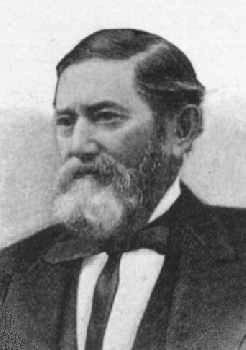
Jack Hays
Many years afterwards, the Comanche chief who led his
warriors on this occasion, asked a friendly Delaware who it was that
made so brave a fight on this occasion. The Delaware replied, that it
was Captain Jack Hays, and his Texas Rangers. The chief shook his head
and said that he never wanted to fight him again, for his men had a
shot for every finger on his hand, and that the Comanches lost half
of their number. He also stated that the warriors died for a hundred
miles back towards Devil’s River.
About 1844, while scouting in the present Gillespie County,
Capt. Jack Hays in charge of a detachment of fourteen men, discovered
about fifteen Comanche warriors who showed signs of wanting to fight;
but Hays realizing that the Indians, no doubt, were endeavoring to ambush
the Texans, led his men around the timber and stationed them on a ridge,
separated from the Indians by a narrow valley. The Comanches realizing
that their strategic maneuvers had failed to decoy the rangers about
seventy-five in number rode out into the open, and summoned Captain
Hays and his men for a fight. The challenge was accepted and the rangers
slowly rode down the hill in the Indians’ direction. But contrary
to expectation instead of charging in front, they followed a ravine
and charged the Indians in the rear. This, of course, somewhat demoralized
the Indians, who nervously awaited the first appearance of the Texans
from the opposite direction. The Indians, however, soon rallied and
made a countercharge. Captain Hays ordered his men to be ready, and
they waited until the Indians were almost within throwing distances
with their lances, before they fired a single shot. Twenty-one warriors
almost immediately fell from their horses, and the Indians fell back
in confusion. The rangers in turn charged the retreating savages. Charge
after charge was made by both the Indians and rangers; and the fight
lasted nearly an hour. The Texans had almost exhausted their loads in
both revolvers and rifles. Capt. Jack Hays asked who was loaded. Ab
Gillespie replied that he was, and Hays told him to dismount and made
sure work of the chief as that would, no doubt, end the fight. Although
the ranger was badly wounded, he tumbled the chief from his horse. The
Comanches now retreated and when the smoke of battle had cleared away,
thirty dead Indians remained to indicate the accuracy of the Texans’
deadly aim.
In his book, Indian Depredations in Texas, J.W. Wilbarger provides a description of Hays' victory:
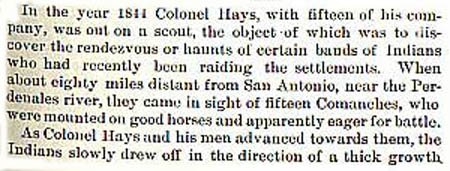
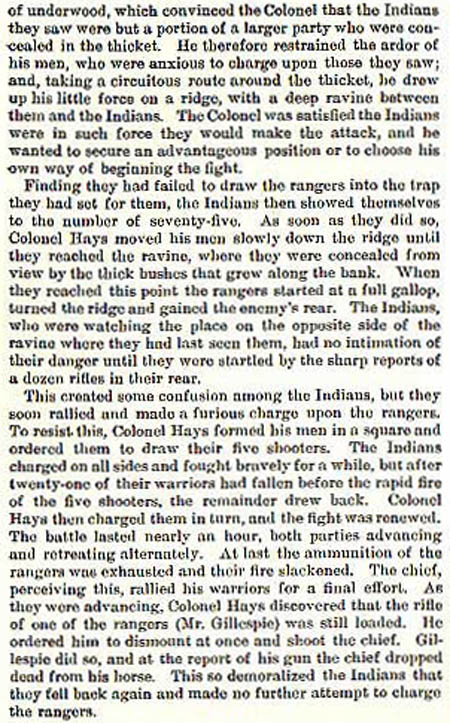
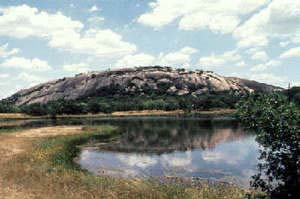
Enchanted Rock
On one occasion when Capt. Jack Hays and about twenty
members of his company were scouting in the vicinity of the Enchanted
Rock, Hays became separated from his companions. At an unexpected moment
he was charged by Indians, and as a consequence, retreated to the Enchanted
Rock. Hays was pursued by the Indians until he reached the summit of
this great wonder of the southwest. Here he entrenched himself in a
crevice and intended to sell his life as dearly as possible. He did
not fire until it became absolutely necessary, and when he did, an Indian
hit the granite. Again and again it became necessary for him to fire,
and nearly every time other Indians were desperately wounded or killed.
For a time the Indians, who were losing heavily, fell back, and this
gave Captain Hays an opportunity to re-load his firearms. And in this
manner for sometime, he made a desperate fight for his life. His comrades
were having a fight of their own near the bottom of the Enchanted Rock,
but could hear the firing of their Captain and screaming of Indians
near the crest of this wonderful structure. As rapidly as possible they
fought their way in his direction, and so deadly was their fire, the
Indians were soon forced to flee. Those warriors who had surrounded
the Captain, now saw the advance of the rangers and immediately retreated
to the opposite side of the Enchanted Rock. Consequently, Capt. Jack
Hays and his men were soon again together, and another victory was added
to the lists of this noble Indian fighter and his men. After the smoke
of the battle had cleared away, five or six Indians lay around the spot
where Hays had fought, and twice the number were found below. Three
or four rangers were seriously, but none fatally wounded. The exact
date of this fight is not known, but it occurred about 1844 or 1845,
and is reported at this particular time.
J.W. Wilbarger's version of the fight appears below. (From the book Indian Depredations in Texas)
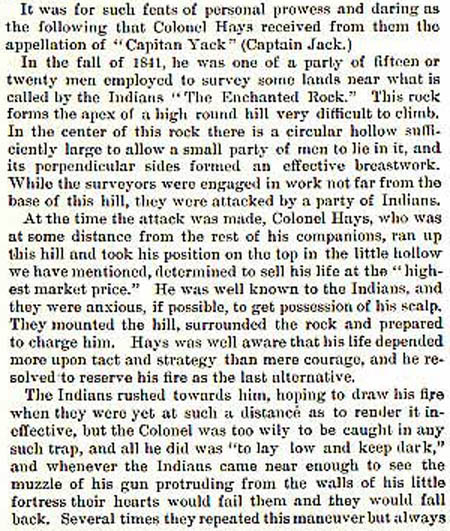
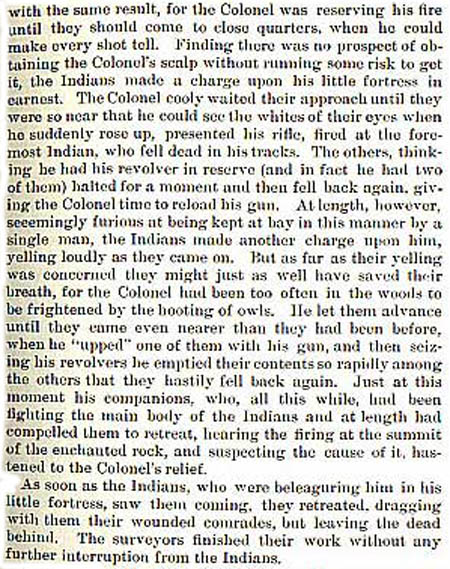
Different accounts do not agree concerning the date
of this engagement. According to one account, it was fought in the
spring of 1841, while others place the date in 1843. Nevertheless,
the story will be related at this time.
Soon after the big raid of the Comanches on Victoria
and Linnville, President Houston felt a stronger need for frontier
protection. So he appointed Capt. John C. Hays to recruit a company
of rangers. Many noted Indian fighters saw service in Capt. John Hays’
company. Among the number were: Big Foot Wallace, Ben Highsmith, Creed
Taylor, Sam Walker, Ed Gillespie, P. H. Bell, Kit Ackland, Sam Luckey,
James Dunn, Tom Galberth, Geo. Neill, Frank Chevallier, and others.
When the famous fight of the Bandera Pass was fought in about 1843,
some of Capt. Hays’ best men at the time, were prisoners in Old
Mexico. But on this particular occasion, Sam Walker, Ed Gillespie,
P. H. Bell, Ben McCulloch, Kit Ackland, Sam Luckey, James Dunn, Tom
Galbreth, Geo. Neill, Frank Chevallier, and others, numbered among
the fighting forces. Hays and his men arrived at the Pass about 11
o’clock in the morning and were unexpectedly charged by a large
band of Comanches. At first his men became somewhat demoralized by
the sudden shock, but the voice of the brave Captain cried out, “Steady
there, boys, dismount and tie those horses, we can whip them. No doubt
about that.” The Colt five and six-shooters had just been invented
and Captain Hays and his men were fortunate to acquire fifty or sixty
of these weapons, which were apparently unknown to the savages. Although
many times outnumbered, the Texans began discharging their rifles
and new pistols, and every shot seemed to strike an Indian. Sam Luckey
was soon wounded and as he fell, Ben Highsmith caught him and laid
him down easy on the ground. He immediately called for water which
was tendered by Highsmith out of the latter’s canteen. The Comanche
chief during the thickest of the fighting, charged and wounded Sergeant
Kit Ackland. Ackland then wounded the chief with his new pistol, and
immediately following the two clinched and went to the ground. Both
of the men were large and fought a terrific combat with their knives.
Over and over they rolled, but finally the ranger was successful in
the duel. Covered with blood and dirt, he then arose from the ground
where lay the chief literally cut to pieces. This engagement of Captain
Hays and his men was one of the most bitter and bloody battles ever
fought in the West and continued until the Indians finally ceased
fighting and retreated to the upper end of the Pass, leaving the rangers
in charge of the battleground. Five rangers, however, lay dead on
the field, and others wounded. A large number of horses were also
killed and their bleaching bones could still be seen in this famous
old Pass for many years afterwards. After the Indians had retreated,
Capt. Hays and his men withdrew to the south entrance of the mountains,
and the night was spent burying the dead and treating the wounded.
During the same time, the Comanches buried their chief near the others
end of the exit through the mountains.
The above stories are from the book, The West Texas
Frontier, by Joseph Carroll McConnell.
The Texas six-shooter was first made famous by a Ranger
captain named Jack Hays. John Coffee Hays was a Tennessean, from the
same county as Andrew Jackson and Sam Houston; in fact, his grandfather
had sold Jackson the Hermitage estate. Hays was a born adventurer,
of the type called forth by many frontiers. He went west to Texas
as a surveyor, was mustered into a ranging company, and suddenly found
his métier. Hays was a natural warrior. He was soon recognized
as the captain of his band, and, at the age of twenty-three, he commanded
the San Antonio station, the most dangerous and important Ranger post
in western Texas.
Jack Hays was the prototype for a certain kind of emerging
American hero. He did not look like a fighting man's hero: he was
slight and slim-hipped, with a clear, rather high voice; he had lovely
manners and was seen as a "perfect gentleman" by the belles
of San Antonio. Hays was utterly fearless-but always within the cold,
hard bounds of practicality, never foolhardy. He was not a talker, and
not even a good gunman, but a born leader of partisans who by great
good luck had been born in the right time and place. Hays was calm
and quiet, almost preternaturally aware of his surroundings and circumstance,
utterly in control of himself, and a superb psychologist, in control
of all the men around him. His actions appeared incredibly daring
to other men who did not have Hay’s capacity for coolly weighing
odds. It is known that most of the other Ranger leaders, and hundreds
of future riders, consciously tried to "be like Jack Hays"-strong,
silent, practical, explosive only in action. He put an indelible stamp
on the force that was soon to be formalized as the Texas Rangers.
He personally trained the great captains Ben McCulloch
and Sam Walker, and his image and example deeply influenced McNelly,
Jones, and Rogers. His example made individual Rangers into one-man
armies.
Hays was the first captain in Texas to recognize the
potentialities of Colt's newfangled revolvers. Because of this, in
early 1840 he fought the first successful mounted action against the
Pehnahterkuh Comanches. Riding beside the Pedernales River northwest
of San Antonio with only fourteen men, Hays was ambushed by a party
of some seventy Comanches. Previously, the standard Texan tactic was
to race for cover and hold off the horsemen with their long rifles-heretofore,
the only hope for survival. Hays, however, wheeled and led his men
in a charge against the howling, onrushing horse Indians; the fourteen
rangers rode through a blizzard of shafts and engaged the Comanches
knee-to-knee with blazing revolvers. Hays lost several men to arrows-but
his repeating pistols struck down a dozen warriors.
Startled, amazed by white men who charged and whose
guns seemed inexhaustible, horrified by heavy losses, the Comanche
war band broke and fled. The Rangers killed thirty Comanches.
The engagement was quickly celebrated along the frontier:
"the best-contested fight that ever took place in Texas,"
in one observer's view. Hays immediately realized that the revolvers,
plus the element of surprise, gave him a great advantage over the
raiders. He resolved to patrol boldly and to meet the enemy on horseback
at every opportunity.
Only a few days afterward, Hay’s company ran into
a vastly superior force of Pehnehterkuh in the Nueces Canyon west
of San Antonio. Hays allowed the warriors to charge, sweep around,
and completely surround him, while his troop dismounted. Then he ordered
his men to discharge their rifles, with deadly effect, and as the
exultant enemy, sure that the white men were now at the Indians' mercy,
swirled in for the kill, he mounted and led a point-blank assault.
Each Ranger singled out a Comanche warrior and rode after him. The
tactic was so surprising that the Texans were at close quarters before
the Comanches reacted.
Hays screamed: "Powder-burn them!" His riders
ripped though the Comanche circle, knocking down warriors left and
right. Enraged, the Comanches swarmed after the Rangers, believing
that they were now fleeing with empty weapons. Hays wheeled about
and charged through them again, fire spitting from his men's pistols,
shooting down the enemy before they could notch bowstring to arrow.
The Comanches, ponies and riders, were thrown into immense confusion.
Again, the Texans singled out individuals, rode beside them cheek
by jowl, and shot them out of the saddle at pointblank range.
Now there occurred that phenomenon that the whites were
to see again and again in the coming years, and which the canny Ranger
captains were to use to their deadly advantage. In the face of something
they could not fully understand-immediate bad medicine-the bravest
of warriors' morale cracked. More of the milling Amerindians were
blasted from their horses by guns that never emptied, the Comanches
became panic-stricken. They screamed and fled as if pursued by Furies.
Great warriors threw away useless shields and spears and rode away
howling, bent low over their horses' sides for protection. In their
flight the Comanches suffered far greater losses than they would have
taken had they pressed the fight. Hays pursued them mercilessly, killing
all he could overtake.
Even after the exhausted Rangers broke off the chase,
the remnants of the war band fled on to the Devil's River, more than
a hundred miles to the west. Fatally wounded warriors fell out and
were abandoned all along the trail. Fully half of the Comanches died,
and the survivors were gripped with superstitious horror. The war
chief, who lived, swore hysterically that he would never face Hay’s
Rangers again.
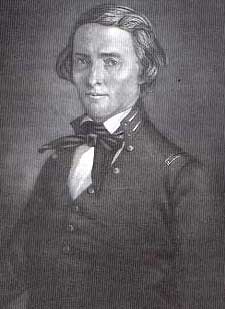
Samuel Walker
Ranger Walker traveled to New York at his own expense to visit Colt.
He persuaded the gun manufacturer to produce a heavier version of
his repeating pistol which would be a .45 calibre six-shooter as opposed
to the .32 calibre five shot version that had been used at Bandera
Pass. The result was a Walker Colt Revolver. The first shipment was
sent to the Ranger forces fighting in the Mexican War.
Hays gave himself no credit; he credited only the Colt
revolvers. This was, of course, too modest, yet the six-shooters did
permit white frontiersmen to meet and match Plains Indians at their
own mode of mounted warfare. Hays and his band were the new breed
of Anglo-American fighting men who had been bred in the West, audacious
and coolly competent, ready to seize any advantage and exploit it
to the hilt. Hays wrote no books and held no classes, but, by example,
he was instructing every Indian fighter near the plains. Incredibly,
almost all that is known of his exploits comes from brief, admiring
mentions by equally inarticulate contemporaries. These, however, show
what he accomplished against the Amerindians.
Hays now took the offensive, riding with confidence
into Pehnahterkuh country. He never commanded more than fifty riders,
but he had learned almost everything there was to learn about Comanche
war warfare. He picked up much from his Lipan scouts, but he also
taught them a few things. He made cold camps and rode silently by
moonlight, like Indians on the war trail, seeking out the Pehnahterkuh
in their scattered lodges and secluded but vulnerable encampments.
Now he hunted Indians. He had learned how to find them, even when
hidden in the most inaccessible canyons, by watching carefully for
the swirl of vultures that followed Comanche lodges. The buzzards
descended regularly to feed on the bloody Amerindian garbage. Hay’s
troop rode like Comanches and attacked like Comanches, with one exception:
Hays and his men were disciplined, purposeful as well as deadly. They
wasted no energy in exultation or victory dances, and no time making
ritual sport with captives. They could not be burdened with prisoners,
and they took none.
If possible, Hays preferred to surprise the Indians
and shoot them down in their sleeping robes, or else surprise a camp
and chase its warriors, dismounted, into brush. The Comanche warrior
was at a tremendous physical and psychological disadvantage when afoot,
and his lances and bows were ineffective in the brushy canyons in
which the Pehnahterkuh, the Honey-Eaters, liked to camp. Hay’s
men mauled the Pehnahterkuh from the Nueces to the Llano, killing
Amerindians of every age and both sexes. By their own lights, defending
a battered, bleeding, ravished frontier, they were not making war
but exterminating dangerous beasts.
Very little mention was made of this, but no one in
Texas would have had it any other way. The Lipan chief, Flacco, was
in awe of Hays, saying often that he was not afraid to ride into hell
all by himself. Lamar’s papers, in an age when few systematic
records were kept and every Texas political figure was inordinately
jealous, indicate that Hay’s troop was instrumental in halting
Comanche depredations on the southwestern frontier in 1840. Even Sam
Houston who deplored wars against the red men and was disgusted with
the brawling Texas borderlands, wrote, “You may depend on the
gallant Hays and his companions.” Hays’s bloody marauding
beyond the frontier was a great factor in the Comanches’ decision
to seek a truce. Other Ranger companies, formalized by the Texan Congress
as border troops, followed his example. The Pehnahterkuh were in no
sense exhausted or defeated, but the warfare against the tejanos was
ceasing to be sport. The Rangers sometimes wiped out camps whose warriors
were away raiding deep in Mexico. Also the Comanches quickly overcame
their initial superstitious fear of repeating pistols. The People
were not given to awe or cringing, and their chiefs quickly understood
that these were only guns of a new and better kind. They desired a
truce so that they might obtain such firearms from traders.
The above story is from the book, Comanches, The Destruction
of a People, by T.R. Fehrenbach.
The following story and picture is from the book, Encyclopedia of Indian Wars, by Gregory F. Michno.
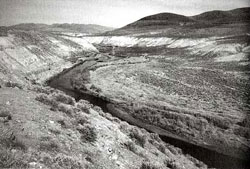
Truckee River
3-4 June 1860, Wadsworth, Nevada: After their fight at Williams Station, John C. Hays and the Washoe Regiment marched north. Capt. Joseph Stewart and his regulars joined them at a campsite on the Truckee River. The next day the combined force moved eight miles down the river and built an earthwork defense. Downriver, in the valley near Pyramid Lake, an advance party found the remains of volunteers from the 12 May rout there. They also spotted 300 Paiute warriors rapidly approaching.
With the Paiutes in pursuit, the vanguard hurried back to the main force. The men formed a skirmish line about a mile long and held the Paiutes back, but they could not drive them from the field. After three hours, at sunset, the Paiutes pulled back north toward the lake. Stewart, Hays, and their men followed for a while, then built a fortification in which to spend the night.
The next morning, the force continued its pursuit, leaving one company in camp to care for the wounded. In a canyon, Paiutes ambushed the five advance riders, killing volunteer William Allen, the expedition's last fatality. After that, the Paiutes vanished; the command reached the south end of Pyramid Lake to find the village gone. After several days, Hays returned to Carson City and disbanded his regiment. Stewart stayed in the area for another month, but the Paiutes did not return.
In all, the regulars and volunteers killed 25 Paiutes and wounded about 20. The Paiutes killed 3 men and wounded 5.
|